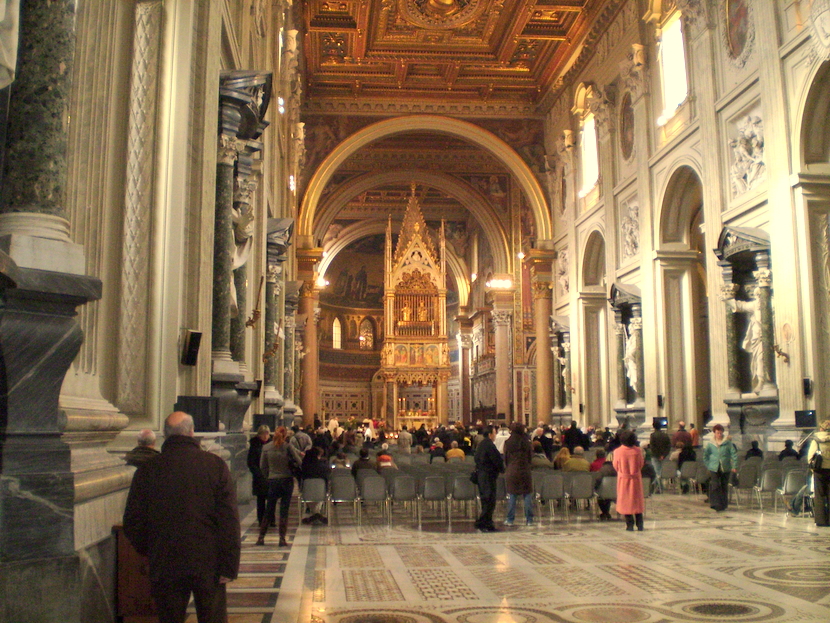Reborn Holy
Dedication of St. John Lateran A (09 Nov 2014)
Homily of Fr. Paul Panaretos, S.J.
The liturgical year has a simple structure. Easter is its hinge, our feast of feasts. The liturgical year revolves around Jesus’ dying, death and resurrection. We celebrate it over three days: the night of Holy Thursday through Good Friday, Holy Saturday into Easter. We tarry 50 days to soak in its mystery and join Messiah Jesus closely. The rest of the year unfolds features of Jesus’ paschal presence with us. Each Sunday is a little Easter: we celebrate his resurrection and rededicate ourselves to our Risen Lord on the Lord’s Day.
 Twelve feasts, when they fall on the Lord’s Day, replace the Sunday liturgy with their liturgies. Each helps us tap into the mystery of Jesus present with us. This year we’ve celebrated four of them: Ss. Peter and Paul (in June); the Exaltation of the Cross (in September); All Souls (last week); and now the Dedication of the Lateran Basilica. The Cathedral church of the Diocese of Rome is named St. John, the patron of the monks who served it.
Twelve feasts, when they fall on the Lord’s Day, replace the Sunday liturgy with their liturgies. Each helps us tap into the mystery of Jesus present with us. This year we’ve celebrated four of them: Ss. Peter and Paul (in June); the Exaltation of the Cross (in September); All Souls (last week); and now the Dedication of the Lateran Basilica. The Cathedral church of the Diocese of Rome is named St. John, the patron of the monks who served it.
Each diocese has its principal church. In it the bishop of the diocese presides. St. John Lateran is the pope’s church as St. Peter Cathedral in Erie is Bishop Persico’s church. We may call St. John Lateran the cathedral of cathedrals; it was dedicated in 324. At that time Rome was the emerging center of Christianity.
As a building no cathedral is greater than those who gather in it; nor is a parish church. In our parish churches we partake in God’s word and sacraments. Here Jesus feeds us his Body. Being parts of Jesus’ body joins parishioners in communion with their diocese; dioceses form the communion of the universal church. The Lateran basilica, the cathedral of cathedrals, symbolizes our catholic, universal, identity.
The word “church” signifies us as the Body of Christ before it signifies a building. In St. Paul’s words: we are God’s building, the temple of [our Messiah’s] body. St. Peter called us living stones: living stones…being built up as a spiritual house, to be a holy priesthood to offer spiritual sacrifices acceptable to God through Jesus Christ.1 We are connected with our Cornerstone Jesus. How does that begin? By Baptism. Baptism unites us to Jesus’ death and resurrection. We are reborn holy for holy living. We gather ’round his table to nourish and sustain our baptisms.
 The baptistry of the Lateran basilica bears an ancient inscription. It reminded those who went under its waters and emerged from them what being reborn holy means:
The baptistry of the Lateran basilica bears an ancient inscription. It reminded those who went under its waters and emerged from them what being reborn holy means:[In this font] is born in Spirit-soaked fertility
a brood destined for another City,
begotten by God’s blowing
and borne upon this torrent
by the Church, their virgin mother.
Reborn in these depths they reach for heaven’s realm, ….
the wounds of Christ its awesome source.
Sinner, sink beneath this sacred surf
that swallows age and spits up youth. …
This spring is life that floods the world,
Sinner, shudder not at sin’s kind and number,
for those born here are holy.2
Those phrases help us ask in concrete ways if we live as reborn holy. Do we reach for heaven’s realm? Or are we flab on our Christ’s Body? Do we tap into the wounds of Christ? Or do we insulate ourselves from his suffering today? Do we obsess and shudder about sin? Or do we put ourselves into Jesus’ care? Today’s feast is less an occasion to focus on a building. It’s another opportunity to rededicate ourselves to Jesus; an opportunity to enjoy felt-knowledge that we are his body reborn, destined for holy living until he returns in glory.
In your daily 15 minutes with Jesus this week
- Consider the thrice-holy name in which you were baptized: Father, Son, Holy Spirit.
- Ask the saints whose names you bear to present you to Jesus.
- Chat with Jesus about how you feel his Spirit has begotten by God’s blowing your Christian life.
- Ask Jesus for grace to be more aware of your baptism and its Christian vocation to live reborn holy.
- Close saying slowly the Lord’s Prayer. Prayed slowly it helps us appreciate how each thing we ask in prayer then do affects our world.
Link to this homily’s Spiritual Exercise
________________
- 1Peter 2.5.
- Perhaps composed by future Pope St. Leo the Great (+461) during the pontificate of Pope St. Sixtus III. The complete inscription in Latin and translation are on pages 5-6 of this brief illustrated history of the Lateran Baptistry.
____________
Wiki-images: Lateran basilica interior Gobbler CC BY-SA 3.0; Lateran baptistry interior Antoine Taveneaux CC BY-SA 3.0
No comments:
Post a Comment